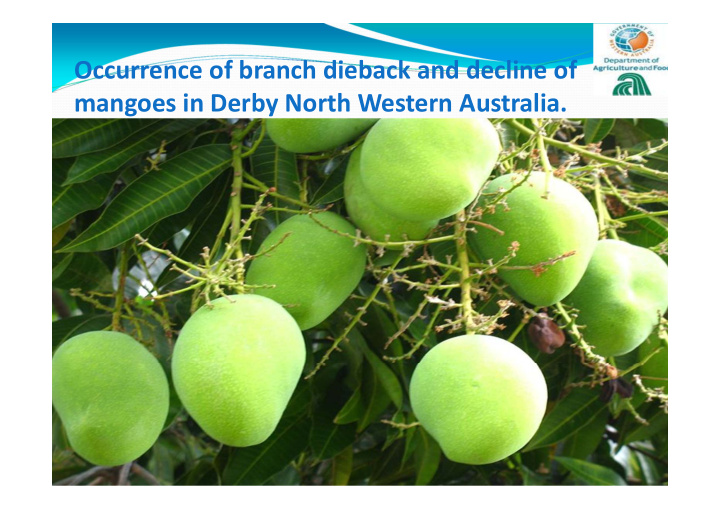



Occurrence of branch dieback and decline of mangoes in Derby North Western Australia.
Symptom of a branch dieback on Kensington cultivar
Pycnidial structures formed on the infected branches.
Morphological characteristics of the isolated fun gi Lasiodiplodia theobromae Pycnidia ; simple or compound, often aggregated, stromatic, ostiolate, up to 2 mm wide. Conidia ; 24-30 × 12-16µm, hyaline and aseptate, becoming dark brown and one-septate. Pseudofusicoccum adansoniae Pycnidia ; 500 µm submerse and solitaries. Conidia ; 20-24 × 4.5-6 µm, ellipsoid straight or slightly curved, hyaline thin walled forming 1-2 septa. Neoscytalidium novaehollandiae Pycnidia ; 300 µm semi-immersed or superficial, solitary or in multilocular black with long neck Conidia ; 1) 10.5-14 × 3.5-5 µm first hyaline becoming cinnamons in color and 0 to 1 septa 2) 8.5-12 × 5.5-7 µm variable in shape globose to obpyriform
Pseudofusicoccum adansoniae ; conidiogenous cells, conidiophores and conidia. Bars 10µm
Lasiodiplodia theobromae ; conidiogenous cells, conidiophores and conidia. Bars 10µm
Neoscytalidium novaehollandiae ; conidiogenous cells, conidiophores and conidia. Bars 10µm
Phylogram of the most parsimonious trees obtained from the ITS sequence data
Mean lesion length (mm) on excised branches of mango inoculated with isolates of P. adansonia (WAC13373), L. theobromae (WAC13374) and N. novaehollandiae (WAC13375). (P = 0.05) Lsd 30 Mean lesion lenght (mm) 25 20 15 10 5 0 W W W C o A A A n C C C t r 1 1 1 o 3 3 3 l 3 3 3 7 7 7 4 3 5 Botryosphaeria species
CONCLUSION Lasiodiplodia theobromae, Pseudofusicoccum adansoniae and Neoscytalidium novaehollandiae are components of dieback and decline of the mango trees in Derby. Lasiodiplodia theobromae and Neoscytalidium novaehollandiae are highly pathogenic in comparison to Pseudofusicoccum adansoniae . Botryosphaeria species are endophytes and opportunistic pathogens, on the trees experiencing stress, Further investigation is needed to identify stress related factors in mango orchards.
ACKNOWLEDGMENTS I would like to thank Cuiping Wang and Paula Mather for their technical assistance.
Recommend
More recommend